5 Which of the following events after the balance sheet date would normally qualify as adjusting events accordingto IAS 10 Events after the balance sheet date?1 The bankruptcy of a credit customer with a balance outstanding at the balance sheet date.2 A d
题目
5 Which of the following events after the balance sheet date would normally qualify as adjusting events according
to IAS 10 Events after the balance sheet date?
1 The bankruptcy of a credit customer with a balance outstanding at the balance sheet date.
2 A decline in the market value of investments.
3 The declaration of an ordinary dividend.
4 The determination of the cost of assets purchased before the balance sheet date.
A 1, 3, and 4
B 1 and 2 only
C 2 and 3 only
D 1 and 4 only
相似考题
参考答案和解析
更多“5 Which of the following events after the balance sheet date would normally qualify as adjusting events accordingto IAS 10 Events after the balance sheet date?1 The bankruptcy of a credit customer with a balance outstanding at the balance sheet date.2 A d”相关问题
-
第1题:
16 Which of the following events between the balance sheet date and the date the financial statements are
authorised for issue must be adjusted in the financial statements?
1 Declaration of equity dividends.
2 Decline in market value of investments.
3 The announcement of changes in tax rates.
4 The announcement of a major restructuring.
A 1
A 1 only
B 2 and 4
C 3 only
D None of them
正确答案:D
-
第2题:
(b) Prepare the balance sheet of York at 31 October 2006, using International Financial Reporting Standards,
discussing the nature of the accounting treatments selected, the adjustments made and the values placed
on the items in the balance sheet. (20 marks)
正确答案: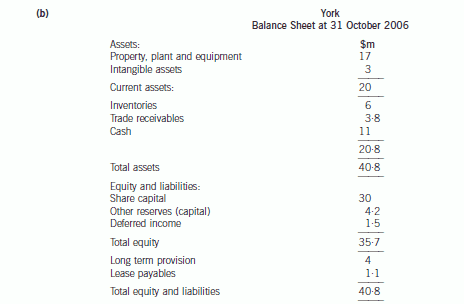
Gow’s net assets
IAS36 ‘Impairment of Assets’, sets out the events that might indicate that an asset is impaired. These circumstances include
external events such as the decline in the market value of an asset and internal events such as a reduction in the cash flows
to be generated from an asset or cash generating unit. The loss of the only customer of a cash generating unit (power station)
would be an indication of the possible impairment of the cash generating unit. Therefore, the power station will have to be
impairment tested.
The recoverable amount will have to be determined and compared to the value given to the asset on the setting up of the
joint venture. The recoverable amount is the higher of the cash generating unit’s fair value less costs to sell, and its value-inuse.
The fair value less costs to sell will be $15 million which is the offer for the purchase of the power station ($16 million)
less the costs to sell ($1 million). The value-in-use is the discounted value of the future cash flows expected to arise from the
cash generating unit. The future dismantling costs should be provided for as it has been agreed with the government that it
will be dismantled. The cost should be included in the future cash flows for the purpose of calculating value-in-use and
provided for in the financial statements and the cost added to the property, plant and equipment ($4 million ($5m/1·064)).
The value-in-use based on a discount rate of 6 per cent is $21 million (working). Therefore, the recoverable amount is
$21 million which is higher than the carrying value of the cash generating unit ($20 million) and, therefore, the value of the
cash generating unit is not impaired when compared to the present carrying value of $20 million (value before impairment
test).
Additionally IAS39, ‘Financial Instruments: recognition and measurement’, says that an entity must assess at each balance
sheet date whether a financial asset is impaired. In this case the receivable of $7 million is likely to be impaired as Race is
going into administration. The present value of the estimated future cash flows will be calculated. Normally cash receipts from
trade receivables will not be discounted but because the amounts are not likely to be received for a year then the anticipated
cash payment is 80% of ($5 million × 1/1·06), i.e. $3·8 million. Thus a provision for the impairment of the trade receivables
of $3·2 million should be made. The intangible asset of $3 million would be valueless as the contract has been terminated.
Glass’s Net Assets
The leased property continues to be accounted for as property, plant and equipment and the carrying amount will not be
adjusted. However, the remaining useful life of the property will be revised to reflect the shorter term. Thus the property will
be depreciated at $2 million per annum over the next two years. The change to the depreciation period is applied prospectively
not retrospectively. The lease liability must be assessed under IAS39 in order to determine whether it constitutes a
de-recognition of a financial liability. As the change is a modification of the lease and not an extinguishment, the lease liability
would not be derecognised. The lease liability will be adjusted for the one off payment of $1 million and re-measured to the
present value of the revised future cash flows. That is $0·6 million/1·07 + $0·6 million/(1·07 × 1·07) i.e. $1·1 million. The
adjustment to the lease liability would normally be recognised in profit or loss but in this case it will affect the net capital
contributed by Glass.
The termination cost of the contract cannot be treated as an intangible asset. It is similar to redundancy costs paid to terminate
a contract of employment. It represents compensation for the loss of future income for the agency. Therefore it must be
removed from the balance sheet of York. The recognition criteria for an intangible asset require that there should be probable
future economic benefits flowing to York and the cost can be measured reliably. The latter criterion is met but the first criterion
is not. The cost of gaining future customers is not linked to this compensation.
IAS18 ‘Revenue’ contains a concept of a ‘multiple element’ arrangement. This is a contract which contains two or more
elements which are in substance separate and are separately identifiable. In other words, the two elements can operate
independently from each other. In this case, the contract with the overseas company has two distinct elements. There is a
contract not to supply gas to any other customer in the country and there is a contract to sell gas at fair value to the overseas
company. The contract has not been fulfilled as yet and therefore the payment of $1·5 million should not be taken to profit
or loss in its entirety at the first opportunity. The non supply of gas to customers in that country occurs over the four year
period of the contract and therefore the payment should be recognised over that period. Therefore the amount should be
shown as deferred income and not as a deduction from intangible assets. The revenue on the sale of gas will be recognised
as normal according to IAS18.
There may be an issue over the value of the net assets being contributed. The net assets contributed by Glass amount to
$21·9 million whereas those contributed by Gow only total $13·8 million after taking into account any adjustments required
by IFRS. The joint venturers have equal shareholding in York but no formal written agreements, thus problems may arise ifGlass feels that the contributions to the joint venture are unequal.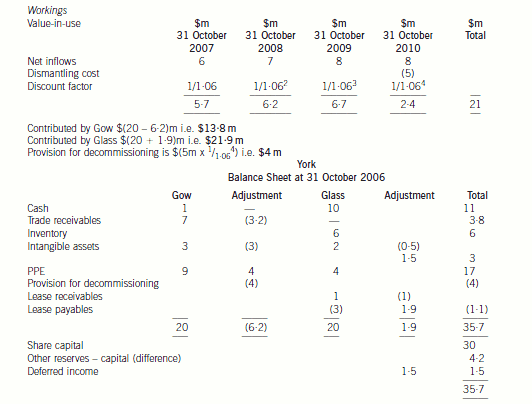
-
第3题:
22 Which of the following statements about limited liability companies’ accounting is/are correct?
1 A revaluation reserve arises when a non-current asset is sold at a profit.
2 The authorised share capital of a company is the maximum nominal value of shares and loan notes the company
may issue.
3 The notes to the financial statements must contain details of all adjusting events as defined in IAS10 Events after
the balance sheet date.
A All three statements
B 1 and 2 only
C 2 and 3 only
D None of the statements
正确答案:D
-
第4题:
(d) Briefly describe the principal audit work to be performed in respect of the carrying amount of the following
items in the balance sheet:
(i) trade receivables; and (3 marks)
正确答案:
(d) Principal audit work
(i) Trade receivables
■ Review of agreements to determine the volume rebates terms. For example,
– the % discounts;
– the volumes to which they apply;
– the period over which they accumulate;
– settlement method (e.g. by credit note or other off-set or repayment).
■ Direct positive confirmation of a value-weighted sample of balances (i.e. larger amounts) to identify potential
overstatement (e.g. due to discounts earned not being awarded).
■ Monitoring of after-date cash receipts and matching against amounts due as shortfalls may indicate disputed
amounts.
■ Review of after-date credit notes to ensure adequate allowance (accrual) is made for discounts earned in the year
to 30 June 2006.
■ Credit risk analysis of individually significant balances and assessment of impairment losses (where carrying value
is less than the present value of the estimated cash flows discounted at the effective interest rate). -
第5题:
You are an audit manager responsible for providing hot reviews on selected audit clients within your firm of Chartered
Certified Accountants. You are currently reviewing the audit working papers for Pulp Co, a long standing audit client,
for the year ended 31 January 2008. The draft statement of financial position (balance sheet) of Pulp Co shows total
assets of $12 million (2007 – $11·5 million).The audit senior has made the following comment in a summary of
issues for your review:
‘Pulp Co’s statement of financial position (balance sheet) shows a receivable classified as a current asset with a value
of $25,000. The only audit evidence we have requested and obtained is a management representation stating the
following:
(1) that the amount is owed to Pulp Co from Jarvis Co,
(2) that Jarvis Co is controlled by Pulp Co’s chairman, Peter Sheffield, and
(3) that the balance is likely to be received six months after Pulp Co’s year end.
The receivable was also outstanding at the last year end when an identical management representation was provided,
and our working papers noted that because the balance was immaterial no further work was considered necessary.
No disclosure has been made in the financial statements regarding the balance. Jarvis Co is not audited by our firm
and we have verified that Pulp Co does not own any shares in Jarvis Co.’
Required:
(b) In relation to the receivable recognised on the statement of financial position (balance sheet) of Pulp Co as
at 31 January 2008:
(i) Comment on the matters you should consider. (5 marks)
正确答案:
(b) (i) Matters to consider
Materiality
The receivable represents only 0·2% (25,000/12 million x 100) of total assets so is immaterial in monetary terms.
However, the details of the transaction could make it material by nature.
The amount is outstanding from a company under the control of Pulp Co’s chairman. Readers of the financial statements
would be interested to know the details of this transaction, which currently is not disclosed. Elements of the transaction
could be subject to bias, specifically the repayment terms, which appear to be beyond normal commercial credit terms.
Paul Sheffield may have used his influence over the two companies to ‘engineer’ the transaction. Disclosure is necessary
due to the nature of the transaction, the monetary value is irrelevant.
A further matter to consider is whether this is a one-off transaction, or indicative of further transactions between the two
companies.
Relevant accounting standard
The definitions in IAS 24 must be carefully considered to establish whether this actually constitutes a related party
transaction. The standard specifically states that two entities are not necessarily related parties just because they have
a director or other member of key management in common. The audit senior states that Jarvis Co is controlled by Peter
Sheffield, who is also the chairman of Pulp Co. It seems that Peter Sheffield is in a position of control/significant influence
over the two companies (though this would have to be clarified through further audit procedures), and thus the two
companies are likely to be perceived as related.
IAS 24 requires full disclosure of the following in respect of related party transactions:
– the nature of the related party relationship,
– the amount of the transaction,
– the amount of any balances outstanding including terms and conditions, details of security offered, and the nature
of consideration to be provided in settlement,
– any allowances for receivables and associated expense.
There is currently a breach of IAS 24 as no disclosure has been made in the notes to the financial statements. If not
amended, the audit opinion on the financial statements should be qualified with an ‘except for’ disagreement. In
addition, if practicable, the auditor’s report should include the information that would have been included in the financial
statements had the requirements of IAS 24 been adhered to.
Valuation and classification of the receivable
A receivable should only be recognised if it will give rise to future economic benefit, i.e. a future cash inflow. It appears
that the receivable is long outstanding – if the amount is unlikely to be recovered then it should be written off as a bad
debt and the associated expense recognised. It is possible that assets and profits are overstated.
Although a representation has been received indicating that the amount will be paid to Pulp Co, the auditor should be
sceptical of this claim given that the same representation was given last year, and the amount was not subsequently
recovered. The $25,000 could be recoverable in the long term, in which case the receivable should be reclassified as
a non-current asset. The amount advanced to Jarvis Co could effectively be an investment rather than a short term
receivable. Correct classification on the statement of financial position (balance sheet) is crucial for the financial
statements to properly show the liquidity position of the company at the year end.
Tutorial note: Digressions into management imposing a limitation in scope by withholding evidence are irrelevant in this
case, as the scenario states that the only evidence that the auditors have asked for is a management representation.
There is no indication in the scenario that the auditors have asked for, and been refused any evidence. -
第6题:
Merchandise inventory at the end of the year was understated. Which of the following statements correctly states the effect of the error.()A.net income is understated
B.net income is overstated
C.merchandise inventory reported on the balance sheet is overstated
D.cost of merchandise sold is understated
正确答案:A
-
第7题:
The income statement is prepared from ().A.the income statement columns of the work sheet
B.the adjusted trial balance
C.either the adjusted trial balance or the income statement columns of the work sheet
D.both the adjusted trial balance and the income statement columns of the work sheet
正确答案:C
-
第8题:
Government securities would appear on a commercial bank's balance sheet as ______.
A.an asset
B.reserves
C.part of net worth
D.a liability
正确答案:A
解析:商业银行持有政府债券是其资产,因此在资产负债表上体现为资产。asset资产。reserves准备金。net worth (NW) 净值。liability负债。balance sheet,资产负债表。 -
第9题:
"Balance Sheet" means the statement on which a bank's assets and liabilities are listed.
A.Right
B.Wrong
C.Doesn't say
正确答案:A
解析:从文中第二句后半部分other on-and-off balance sheet exposures such as guarantees, acceptances and securities investments. 可以倒推出来。资产负债表外业务没有涉及资产和负债,那么资产负债表就应该包含资产和负债。on-and-off balance sheet资产负债表内外,balance sheet。 -
第10题:
What is the short-coming of the concept?
A.The accountant has to restate the assets and liabilities on the balance sheet.
B.It is difficult to compare the balance sheets of different companies.
C.The balance sheet can not reflect the precise worth of the assets and liabilities.
D.Another company will not decide whether to buy the piece of land.
正确答案:C
解析:文章最后一段提到Suppose another company paid…a much higher amount for the land.如果是基于这样一个观点的话,这样一个资产负债表所反映的内容就要比实物要高出很多,由此可知这一观点的缺点在于,资产负债表不能精确的反映资产和负债的实际情况。 -
第11题:
The book value of a fixed asset reported on the balance sheet represents its market value on that date.()
正确答案:错
-
第12题:
名词解释题Balance sheet正确答案: 资产负债表(the Balance Sheet)亦称财务状况表,表示企业在一定日期(通常为各会计期末)的财务状况(即资产、负债和业主权益的状况)的主要会计报表。解析: 暂无解析 -
第13题:
(b) Prepare a consolidated balance sheet as at 31 October 2005 for the Lateral Group in accordance with
International Financial Reporting Standards. (21 marks)
正确答案:
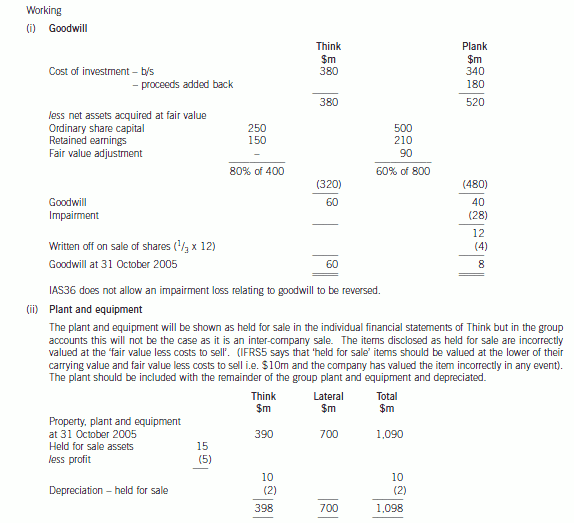
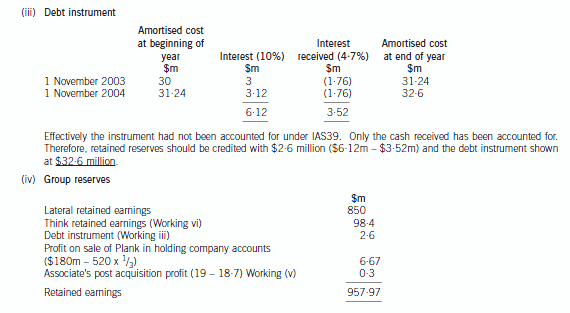
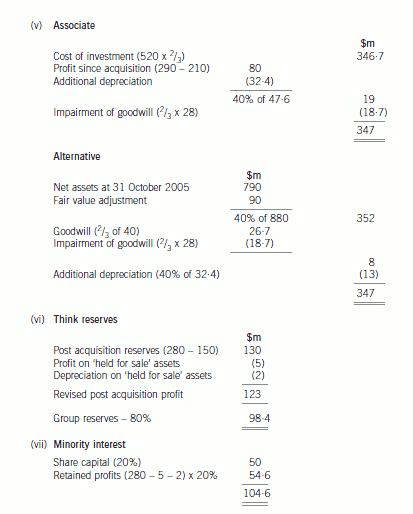
-
第14题:
20 Which of the following events occurring after the balance sheet date are classified as adjusting, if material?
1 The sale of inventories valued at cost at the balance sheet date for a figure in excess of cost.
2 A valuation of land and buildings providing evidence of an impairment in value at the year end.
3 The issue of shares and loan notes.
4 The insolvency of a customer with a balance outstanding at the year end.
A 1 and 3
B 2 and 4
C 2 and 3
D 1 and 4
正确答案:B
-
第15题:
12 Which of the following statements are correct?
(1) Contingent assets are included as assets in financial statements if it is probable that they will arise.
(2) Contingent liabilities must be provided for in financial statements if it is probable that they will arise.
(3) Details of all adjusting events after the balance sheet date must be given in notes to the financial statements.
(4) Material non-adjusting events are disclosed by note in the financial statements.
A 1 and 2
B 2 and 4
C 3 and 4
D 1 and 3
正确答案:B
-
第16题:
(b) Explain the principal audit procedures to be performed during the final audit in respect of the estimated
warranty provision in the balance sheet of Island Co as at 30 November 2007. (5 marks)
正确答案:
(b) ISA 540 Audit of Accounting Estimates requires that auditors should obtain sufficient audit evidence as to whether an
accounting estimate, such as a warranty provision, is reasonable given the entity’s circumstances, and that disclosure is
appropriate. One, or a combination of the following approaches should be used:
Review and test the process used by management to develop the estimate
– Review contracts or orders for the terms of the warranty to gain an understanding of the obligation of Island Co
– Review correspondence with customers during the year to gain an understanding of claims already in progress at the
year end
– Perform. analytical procedures to compare the level of warranty provision year on year, and compare actual to budgeted
provisions. If possible disaggregate the data, for example, compare provision for specific types of machinery or customer
by customer
– Re-calculate the warranty provision
– Agree the percentage applied in the calculation to the stated accounting policy of Island Co
– Review board minutes for discussion of on-going warranty claims, and for approval of the amount provided
– Use management accounts to ascertain normal level of warranty rectification costs during the year
– Discuss with Kate Shannon the assumptions she used to determine the percentage used in her calculations
– Consider whether assumptions used are consistent with the auditors’ understanding of the business
– Compare prior year provision with actual expenditure on warranty claims in the accounting period
– Compare the current year provision with prior year and discuss any fluctuation with Kate Shannon.
Review subsequent events which confirm the estimate made
– Review any work carried out post year end on specific faults that have been provided for. Agree that all costs are included
in the year end provision.
– Agree cash expended on rectification work in the post balance sheet period to the cash book
– Agree cash expended on rectification work post year end to suppliers’ invoices, or to internal cost ledgers if work carried
out by employees of Island Co
– Read customer correspondence received post year end for any claims received since the year end. -
第17题:
The main liability on a bank balance sheet is ______.
A.deposits
B.capital and reserves
C.loans and overdrafts
D.cash
正确答案:A
解析:deposits存款。liability负债。bank balance sheet银行资产负债表。capital and reserves资本金和准备金。loans and overdrafts贷款与透支。cash现金。 -
第18题:
During a period of falling prices, which of the following inventory s generally results in the lowest balance sheet amount for inventory. ()A.can not tell without more ination
B.average
C.LIFO
D.FIFO
正确答案:D
-
第19题:
听力原文:M: Can you tell me something about a balance sheet?
W: Yes. It is divided into three sections: assets, liabilities, and owner's equity and it is used to summarize a company's financial position on a given date.
Q: Which of the following is not a section of a balance sheet?
(15)
A.Profit and Joss
B.Owner's equity.
C.Liabilities
D.Assets.
正确答案:A
解析:根据女士回答资产负债表分为三部分,即"assets", "liabilities" 和"owner's equity",A项未提及。 -
第20题:
A balance sheet is simply the enumeration of the various assets of a business on one side of a ledger and the enumeration of various liabilities and (61) accounts on the other side. The two sides must be equal, or balance. Only one further point should be (62) : A balance sheet refers to a single point in time, for example, the close of business on December 31. Taken by itself, a balance sheet does not show (63) over time. It is what economists call a stock concept, not a (64) concept. That is, the balance sheet shows the stock of goods a firm has on hand at any particular instant and does not show the flow of goods through the firm over time. For this reason, a balance sheet does not show business (65) , which are a flow.
(46)
A.profit
B.capital
C.income
D.cash
正确答案:B
解析:资产负债表分为三部分:资产、负债、所有者权益。capital accounts等于owner's equity。 -
第21题:
What does the accountant do in recording assets and liabilities according to the stable-monetary-unit concept?
A.He simply adds all the amounts together.
B.He puts the assets and liabilities on the balance sheet objectively.
C.He makes restatement if the value of money depreciates.
D.He records the assets and liabilities on the balance sheet ignoring the change in purchasing power value of the currency.
正确答案:D
解析:文章最后一段提到The stable-monetary-unit concept is the accountant's…the changing value of the dollar。统一货币计量单位使得会计在编制资产负债表的时候不用去考虑 通货膨胀和美元贬值的影响。所以D选项符合题意。 -
第22题:
The balance of the allowance for doubtful accounts is added to accounts receivable on the balance sheet.()
正确答案:错
-
第23题:
Balance sheet
正确答案: 资产负债表(the Balance Sheet)亦称财务状况表,表示企业在一定日期(通常为各会计期末)的财务状况(即资产、负债和业主权益的状况)的主要会计报表。
